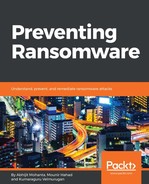Crypto ransomware technically does the following things:
- Finds files on the local system. On a Windows machine, it can use the FindFirstFile(), FindNextFile() APIs to enumerate files directories.
- A lot of ransomware also search for files present on shared drives
- It next checks for the file extension that it needs to encrypt. Most have a hardcoded list of file extensions that the ransomware should encrypt. Even if it encrypts executables, it should not encrypt any of the system executables.
- It makes sure that you should not be able to restore the files from backup by deleting backup. Sometimes, this is done by using the vssadmin tool. A lot of crypto ransomwares use the vssadmin command, provided by Windows to delete shadow copies. Shadow copies are backups of files and volumes. The vssadmin (vss administration) tool is used to manage shadow copies. VSS in is abbreviation of volume shadow copy also termed as Volume Snapshot Service. The following is a screenshot of the vssadmin tool:

Fig. vssadmin tool command
- After encrypting the files ransomware leaves a note for the victim . It is often termed a ransom note, and is a message from the ransomware to the victim. It usually informs the victim that the files on his system have been encrypted and to decrypt them, he needs to pay a ransom. The ransom note instructs the victim on how to pay ransom.
- The ransomware uses a few cryptographic techniques to encrypt files, communicate with the C&C server, and so on. We will explain this in an example in the next section. But before that, it's important to take a look at the basics of cryptography.
